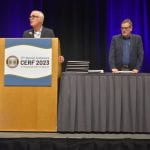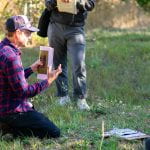
In October we spoke with Prof. Amalia Kokkinaki to congratulate her on the recent grant she and her collaborators received from the Environmental System Science (ESS) Funding Opportunity Announcement through the U.S. Department of Energy (DOE). Their research project “Deciphering the Role of Anaerobic Microsites for Hot Spot/Hot Moment Dynamics of Metal Redox Chemistry and Methane Emissions within Riverine Floodplains” is being carried out by Principal Investigator Amrita Bhattacharyya from USF and co-PIs Amalia Kokkinaki from USF, Ruth M. Tinnacher from CSU East Bay, and Kristin E. Boye and Vincent Noël from SLAC.
Anaerobic microsites are spots in the shallow subsurface where oxygen is depleted within an otherwise overall oxic environment. These anoxic zones tend to occur at terrestrial-aquatic interfaces (TAI), such as riverine floodplains, because of the seasonal fluctuations between the river and groundwater causing redox changes. The research team is studying anoxic microsites because they are a significant contributor to global methane (CH4) production, predicted to be producing 21% of CH4 emissions. Prof. Kokkinaki and the other researchers are conducting field and lab work to create models that predict the conditions under which floodplains emit the most methane (CH4). The team will be collecting and analyzing new soil data from specific DOE ESS natural floodplain research sites.

Using advanced imaging technologies at SLAC, the project will study the chemistry and behavior of anaerobic microsites to determine how these microsites may be significant in methanogenesis and metal redox processes. The team’s research will be significant in leading the way for future research and predictions of metal cycling and the production of greenhouse gas emissions within TAI environments.
If you see Prof. Kokkinaki, be sure to congratulate her and stay tuned as we share more about her work within the MSEM program and share advice for those entering their Master’s Project. Prof. Kokkinaki also encourages any MSEM students interested in her research to reach out if they would like to be involved!






